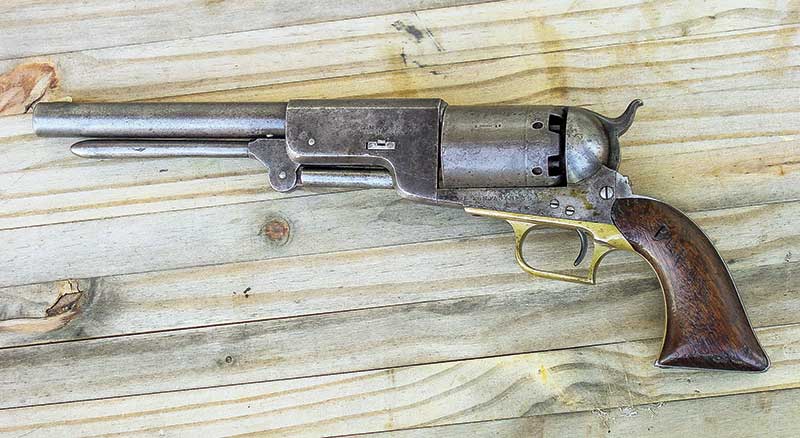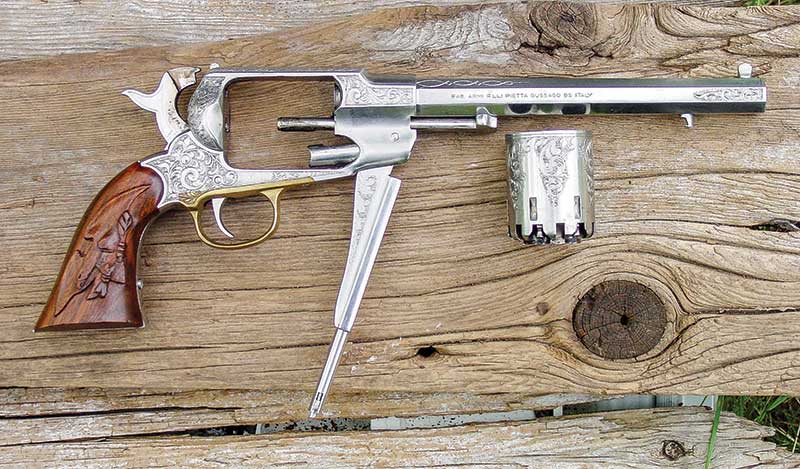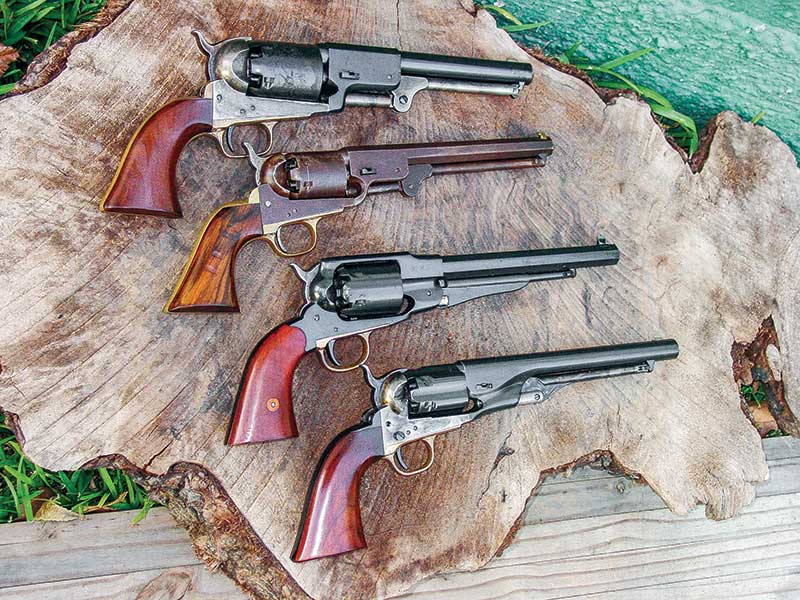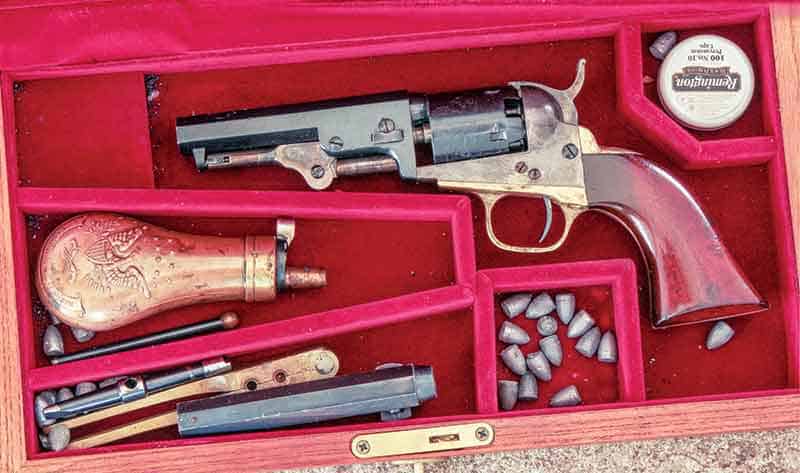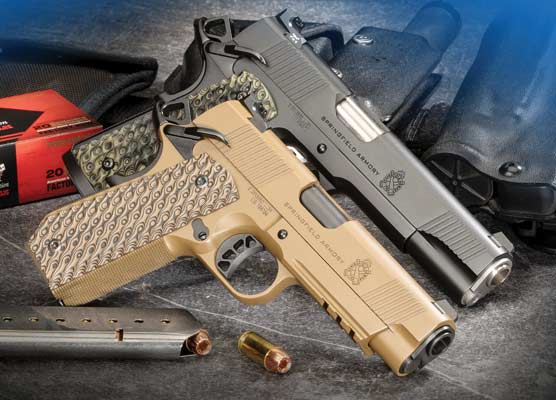Currently we have single-action revolvers mimicking Colt designs from 1836 through 1860 such as Beal Patent Remingtons, LeMats and the very well done Rogers and Spencer from Euroarms. These all have a half-cock hammer position freeing the cylinder to rotate for loading and provisions for setting the hammer down safely between chambers. Colt and Remington copies from Uberti and Pietta are the most widely distributed while Taylor, Cimarron Arms and VTI Gunparts all keep comprehensive stocks of spare parts. VTI has a gunsmithing service for the major brands and originals. It is quite expensive but may prove a valuable resource when the handgun goes discompuesto and is beyond the owner’s mechanical capabilities.
Percussion Revolver 101
Big Smoke Means Big Fun
Shooting pre-cartridge black powder revolvers is solidly ensconced in worldwide shooting culture. They provide a tangible link with history, develop the same skill sets as modern firearms and are often less encumbered with regulation.
Early replicas were plagued with brittle screws and the fragile leaf springs and action parts which went “snap, crackle and pop” with regularity. The need for occasional spring replacement is still a reality but current improvements in overall quality and metallurgy have rendered the occasional busted leaf spring mildly surprising rather than a regular occurrence.
The Guns
Currently we have single-action revolvers mimicking Colt designs from 1836 through 1860 such as Beal Patent Remingtons, LeMats and the very well done Rogers and Spencer from Euroarms. These all have a half-cock hammer position freeing the cylinder to rotate for loading and provisions for setting the hammer down safely between chambers. Colt and Remington copies from Uberti and Pietta are the most widely distributed while Taylor, Cimarron Arms and VTI Gunparts all keep comprehensive stocks of spare parts. VTI has a gunsmithing service for the major brands and originals. It is quite expensive but may prove a valuable resource when the handgun goes discompuesto and is beyond the owner’s mechanical capabilities.
The Loads
1. Black Powdera — The only American black powder manufacturer is Goex Powder, Inc. which started life in 1802 at the Belin Works of the E.I. du Pont de Nemours & Co. This plant operated essentially the same for decades but was purchased in the 1990s by Goex and resulted in the facilities moving to Minden, Louisiana. In 2009, Hodgen Powder Company purchased the plant and continues to manufacture “the real stuff” in various sizes and grades. There are also many black powders available from Europe such as the Schuetzen and Swiss brands
2. Black Powder substitutes — They come and they go. Pyrodex in Pistol granulation performs much like the high quality Swiss FFFg Black Powder. It has outlasted several formulae that demonstrated lack-luster performance. Black Powder is very consistent, has an apparently indefinite shelf life and ignites easily. Pyrodex is harder to ignite but provides low velocity spreads and is regulated the same as smokeless propellant. Black Powder is regulated as an explosive and more difficult to find.
3. Balls or bullets — Round balls allow for large powder charges, higher velocity and excellent accuracy. There is no practical reason, beyond experimentation and historic verisimilitude, to use bullets or paper cartridges — in spite of the incorrect nattering by The Foremost Authorities declaring conical bullets significantly less accurate. Conical bullets from Lee Molds, Dixie Scissor molds or originals are quite accurate if the rammer stem has been configured to fit the bullet nose.
4. Wads and grease — More on this later.
5. Percussion caps — There are several varieties with CCI and Remington being widely distributed. The universal recommendation for revolvers is the number 11 cap though some smaller pistols are better served with number 10. CCI caps of either size are tighter than Remington and harder to set off.
Projectile Sizes
Appropriate ball diameter for the .31 caliber revolvers is 0.320-0.323″. Smaller balls marked “31 Caliber” are for use with patches in rifles. The same is true with balls marked .36 or .44. The .36 caliber revolver balls measure 0.375″ or 0.380″ — the smaller diameter works well in Pietta revolvers but 0.380″ is optimal for Uberti chambers. A slightly out-of-round 0.375″ ball will often come out of the ramming sequence stuck to the loading stem. The 0.380″ will work for both.
“Forty Four” balls available in 0.451″ work fine in Pietta and EuroArms. A 0.454″ ball is ideal for Uberti chambers and will work in both. Original Remington New Model Army revolvers use 0.457″ as do the variations on the Ruger Old Army.
Loading For Success
First, remove all traces of oil from the chambers and make sure the nipple (cone) channels are clear.
Now, from the original Colt broadside:
Draw the hammer to the half-cock notch which allows the cylinder to be rotated. A charge of powder is then placed in each chamber and the balls, without wadding or patch, are put one at a time on the mouths of each chamber, turned under the rammer and forced down with the lever below the mouth of the chamber. This is repeated until all the chambers are loaded. Percussion caps are placed on the tubes when, by drawing back the hammer to the full catch, the arm is in a condition for a discharge by pulling the trigger: a repetition of the same motion produces the like result. To carry the pistol safely, it is necessary to lower the hammer on to one of the pins on the end of the cylinder between each cone.
Dispatches from 1849 describe soldiers in the Mexican War putting grease over the mouth of each chamber to prevent multiple ignitions and exploded revolvers. Later on, this practice was also supposed to keep powder fouling soft. Colt’s instructions came considerably later and make no mention of applying grease.
Correctly-fitting balls and bullets effectively prevent cross-firing and vaporized grease does not keep fouling soft but actually encourages its accretion. Exploded percussion caps are also prone to stick to a greasy hammer face, blocking subsequent ignition and dropping fragments into the action to bind it up. Since grease-sealing the chamber mouths is a Shibboleth found in much literature and many instruction manuals, many people are wedded to the practice. However, in truth, they can minimize malfunctions by merely wiping the hammer face and the portion of the breech under the hammer between loadings.
The use of wool-felt, sheep-tallow wads under the bullet is another matter. Elmer Keith said he talked to early westerners who could keep the barrel of their percussion revolvers free of fouling by using wads cut from old hats and treated with sheep tallow, then blowing across the muzzle after shooting. This works. The shooter who elects to load balls or bullets directly over the powder charge can keep the revolver shooting accurately by running a damp patch through the barrel after every full cylinder. Windex is popular for this but spit works just as well.
Shooting For Success
The goal is the reasonable expectation of reliability. Upon firing, the percussion cap frequently explodes and flares. Ideally the fragments will travel with the cylinder around the breech face and fall free at the capping window. Holding the revolver level or executing the ill-conceived “Gunfighter Flip” while cocking allows the burst fragment to fall down on the hammer face and into the inner workings of the action, locking everything up as tight as the southern aspect of a north-vectoring mallard. Cocking the arm with the muzzle at a downward angle minimizes this and the absence of grease-imbued fouling on the hammer face and breech virtually eliminates the problem.
If, as is often the case with the pocket models, there is insufficient clearance between cylinder and the right side of the breech, cap travel can be freed up without visible mischief by increasing the clearance. Should fouling become excessive, cleaning the arbor and other close components ought to maintain smooth function. A drop of spit on the arbor can also be beneficial.
Cleaning
Proper cleaning is a tedious necessity requiring disassembly of the revolver to major components without delay. If out of reach of an ideal cleaning environment for a few days, the revolver can be kept free of rust by using standard petroleum-based oil. The full cleaning drill involves thorough flushing with hot water and mild detergent. A favored formula is a mixture of Murphy’s oil soap, hydrogen peroxide, alcohol and dish soap in a spray dispenser. Heat drying by immersion in clean boiling water works well and is immediate, thorough saturation (after the water steams off) with CLP-grade oil affords long-term protection from rust and corrosion. The revolvers in these pictures have undergone this treatment many times with little or no degradation of the factory finishes.
